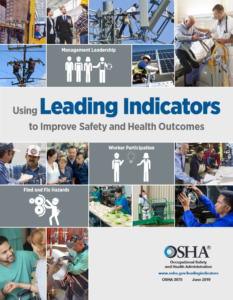 Leading indicators are proactive and preventative measures that can help determine whether your safety and health activities are effective at preventing incidents or whether there are potential problems with your safety and health program. Leading indicators play an important role in preventing worker fatalities, injuries and illnesses, and strengthening other safety and health outcomes in the workplace.
Leading indicators are proactive and preventative measures that can help determine whether your safety and health activities are effective at preventing incidents or whether there are potential problems with your safety and health program. Leading indicators play an important role in preventing worker fatalities, injuries and illnesses, and strengthening other safety and health outcomes in the workplace.
An example of a good leading indicator might be the amount of time it takes to respond to a safety hazard report. A decrease in the response time may demonstrate an increase in safety awareness and a deeper commitment of your managers to workplace safety. Other examples of leading indicators include the percentage of workers who attend safety refresher training and the number of times each month that top management initiates discussion of a safety and health topic.
OSHA has published Using Leading Indicators to Improve Safety and Health Outcomes to help employers and workers understand how leading indicators can help improve safety and health programs.
Leading indicators can play a vital role in preventing worker fatalities, injuries and illnesses. Employers who use leading indicators as a tool for achieving safety goals have a substantial advantage over their competitors. By taking deliberate and measured actions that can prevent fatalities, injuries and illnesses, employers demonstrate their commitment to maintaining a socially responsible workplace that values workers. By strengthening key elements of their safety and health programs, they also can improve their overall organizational performance.
